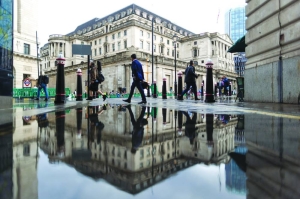Global South
UK enjoys best growth in Group of Seven nations in first half

[ad_1]

Commuters pass the Bank of England building in the City of London. Britain’s economy is enjoying a “Goldilocks moment” with slowing inflation, rising employment and healthy growth that’s likely to set the stage for a more comfortable backdrop both for the BoE and Keir Starmer’s government.
Britain’s economy is enjoying a “Goldilocks moment” with slowing inflation, rising employment and healthy growth that’s likely to set the stage for a more comfortable backdrop both for the Bank of England (BoE) and Keir Starmer’s government.
A strong performance in the second quarter meant the UK enjoyed the best growth in the Group of Seven nations in the first half of 2024, outstripping the US and well ahead of other European countries. Official data this week also showed that workers were hired at the quickest pace since November, reducing the jobless rate, while inflation rose less than expected.
The figures leave the UK threading a narrow path, with the economy running just hot enough to put last year’s recession further in the rear-view mirror while cool enough to allow the BoE to proceed with lowering interest rates later this year. The risk is that constraints on the size of the workforce and productivity weigh down a recovery that business groups warn remains quite fragile.
“The economic data released this week portrayed a somewhat Goldilocks scenario for the UK,” said Ellie Henderson, UK economist at Investec.
For Dan Hanson at Bloomberg Economics, the “sweet spot” the UK is enjoying now could turn “challenging” in the longer run with a slowdown in the third quarter and beyond.
Starmer pledged to “take the brakes off Britain” after his win in the July 4 election, taking early steps to reform planning rules that hold up construction and get people back into jobs after many workers dropped out of the labour market since the pandemic.
BoE Governor Andrew Bailey and his colleagues are acutely aware of those limitations and watching carefully for signs that inflation will stick around. Investors currently expect only one or two more interest rate cuts this year after an Aug. 1 decision ease from a 16-year high.
But this week’s data held good news, growth that had eluded the UK in recent years without immediately triggering inflation:
n After rebounding from recession with growth of 0.7% in the first quarter, data this week showed GDP rose 0.6% in the second quarter, “another gangbusters” set of figures, according to Yael Selfin, chief economist at KPMG UK.
n Inflation came in below expectations on Wednesday, edging up slightly to 2.2% in July. Services inflation — a crucial gauge of domestic pressures for the BoE — fell sharply to 5.2%, the lowest in over two years.
n Jobs data for the three months to June showed the biggest hiring spurt since November, even as regular wage growth cooled to a near two-year low of 5.4%.
n Retail sales rebounded in July, reversing some of the slump in June, with summer discounts and the Euros football tournament lifting spending.
The growth outlook meanwhile is on track for a “just right” temperature that Goldilocks enjoyed in the classic English fairy tale.
Forecasters surveyed by Bloomberg expect a 0.3% expansion in each quarter from here on through the end of 2025. The economists predict growth of 1% this year, accelerating to 1.3% in 2025 and 1.5% in 2026. The Office for Budget Responsibility expects even better growth of around 2% in the next and following year.
That makes more plausible Starmer’s goal of the highest sustained growth among the G7 nations and his lofty ambition for a 2.5% rise in GDP every year. He and Chancellor of the Exchequer Rachel Reeves are seeking to get the economy growing at the healthier rates seen before the financial crisis, helping to generate more money to pump into struggling public services.
“We think the UK economy has now firmly exited the stagnation phase of the last four years and will continue to grow solidly over the rest of 2024, and into 2025 as real incomes rise, consumer and business confidence improves and interest rates fall further,” said Thomas Pugh, UK economist at RSM UK.
He said the economy had a “Goldilocks moment” in the second quarter where growth was strong but not too hot to trigger price pressures, though he cautioned that the figures were helped significantly by base effects.
“The risk is that if growth continues at this pace for the rest of the year we end up dipping into the too hot bowl,” said Pugh.
The BoE is sceptical the current pace of growth can last, noting that business surveys suggested that the underlying pace of the economy was weaker than the GDP figures indicate.
“The bigger picture here is it does feel like some of the recent momentum in GDP growth is easing,” said Ashley Webb, UK economist at Capital Economics. “Looking under the surface dampens the goldilocks scenario a bit,” he said, pointing to weaker underlying GDP growth and noisy services inflation data.
Nonetheless the BoE has flagged the threat of more robust growth on its fight to contain inflation. Unless the UK economy is undergoing a fundamental upgrade in its longer run trend growth rate, official forecasters believe it can only expand at a pedestrian pace before running into price pressures.
This year’s fast growth didn’t trigger inflation as it was largely a catch up effect after last year’s recession created more spare capacity in the economy. However, once that catch-up is complete, the UK will only be able to expand at its longer-term trend growth rate before stoking price pressures. Pushing against that constraint could force the BoE to reduce interest rates more cautiously to stop the risk of inflation.
Bloomberg Economics estimates that the UK’s trend growth — the pace it can expand without generating excess inflation — is around 0.3% per quarter, half the rate seen in the second quarter.
A strong performance in the second quarter meant the UK enjoyed the best growth in the Group of Seven nations in the first half of 2024, outstripping the US and well ahead of other European countries. Official data this week also showed that workers were hired at the quickest pace since November, reducing the jobless rate, while inflation rose less than expected.
The figures leave the UK threading a narrow path, with the economy running just hot enough to put last year’s recession further in the rear-view mirror while cool enough to allow the BoE to proceed with lowering interest rates later this year. The risk is that constraints on the size of the workforce and productivity weigh down a recovery that business groups warn remains quite fragile.
“The economic data released this week portrayed a somewhat Goldilocks scenario for the UK,” said Ellie Henderson, UK economist at Investec.
For Dan Hanson at Bloomberg Economics, the “sweet spot” the UK is enjoying now could turn “challenging” in the longer run with a slowdown in the third quarter and beyond.
Starmer pledged to “take the brakes off Britain” after his win in the July 4 election, taking early steps to reform planning rules that hold up construction and get people back into jobs after many workers dropped out of the labour market since the pandemic.
BoE Governor Andrew Bailey and his colleagues are acutely aware of those limitations and watching carefully for signs that inflation will stick around. Investors currently expect only one or two more interest rate cuts this year after an Aug. 1 decision ease from a 16-year high.
But this week’s data held good news, growth that had eluded the UK in recent years without immediately triggering inflation:
n After rebounding from recession with growth of 0.7% in the first quarter, data this week showed GDP rose 0.6% in the second quarter, “another gangbusters” set of figures, according to Yael Selfin, chief economist at KPMG UK.
n Inflation came in below expectations on Wednesday, edging up slightly to 2.2% in July. Services inflation — a crucial gauge of domestic pressures for the BoE — fell sharply to 5.2%, the lowest in over two years.
n Jobs data for the three months to June showed the biggest hiring spurt since November, even as regular wage growth cooled to a near two-year low of 5.4%.
n Retail sales rebounded in July, reversing some of the slump in June, with summer discounts and the Euros football tournament lifting spending.
The growth outlook meanwhile is on track for a “just right” temperature that Goldilocks enjoyed in the classic English fairy tale.
Forecasters surveyed by Bloomberg expect a 0.3% expansion in each quarter from here on through the end of 2025. The economists predict growth of 1% this year, accelerating to 1.3% in 2025 and 1.5% in 2026. The Office for Budget Responsibility expects even better growth of around 2% in the next and following year.
That makes more plausible Starmer’s goal of the highest sustained growth among the G7 nations and his lofty ambition for a 2.5% rise in GDP every year. He and Chancellor of the Exchequer Rachel Reeves are seeking to get the economy growing at the healthier rates seen before the financial crisis, helping to generate more money to pump into struggling public services.
“We think the UK economy has now firmly exited the stagnation phase of the last four years and will continue to grow solidly over the rest of 2024, and into 2025 as real incomes rise, consumer and business confidence improves and interest rates fall further,” said Thomas Pugh, UK economist at RSM UK.
He said the economy had a “Goldilocks moment” in the second quarter where growth was strong but not too hot to trigger price pressures, though he cautioned that the figures were helped significantly by base effects.
“The risk is that if growth continues at this pace for the rest of the year we end up dipping into the too hot bowl,” said Pugh.
The BoE is sceptical the current pace of growth can last, noting that business surveys suggested that the underlying pace of the economy was weaker than the GDP figures indicate.
“The bigger picture here is it does feel like some of the recent momentum in GDP growth is easing,” said Ashley Webb, UK economist at Capital Economics. “Looking under the surface dampens the goldilocks scenario a bit,” he said, pointing to weaker underlying GDP growth and noisy services inflation data.
Nonetheless the BoE has flagged the threat of more robust growth on its fight to contain inflation. Unless the UK economy is undergoing a fundamental upgrade in its longer run trend growth rate, official forecasters believe it can only expand at a pedestrian pace before running into price pressures.
This year’s fast growth didn’t trigger inflation as it was largely a catch up effect after last year’s recession created more spare capacity in the economy. However, once that catch-up is complete, the UK will only be able to expand at its longer-term trend growth rate before stoking price pressures. Pushing against that constraint could force the BoE to reduce interest rates more cautiously to stop the risk of inflation.
Bloomberg Economics estimates that the UK’s trend growth — the pace it can expand without generating excess inflation — is around 0.3% per quarter, half the rate seen in the second quarter.
[ad_2]
Source link







